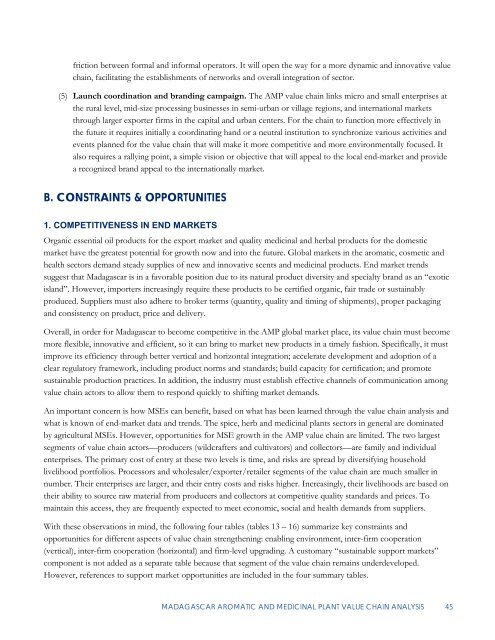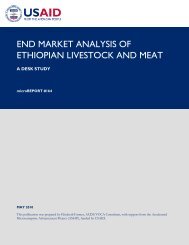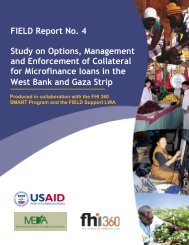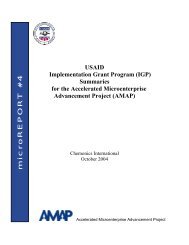Madagascar Aromatic and Medicinal Plants Value - Microlinks
Madagascar Aromatic and Medicinal Plants Value - Microlinks
Madagascar Aromatic and Medicinal Plants Value - Microlinks
Create successful ePaper yourself
Turn your PDF publications into a flip-book with our unique Google optimized e-Paper software.
friction between formal <strong>and</strong> informal operators. It will open the way for a more dynamic <strong>and</strong> innovative value<br />
chain, facilitating the establishments of networks <strong>and</strong> overall integration of sector.<br />
(5) Launch coordination <strong>and</strong> br<strong>and</strong>ing campaign. The AMP value chain links micro <strong>and</strong> small enterprises at<br />
the rural level, mid-size processing businesses in semi-urban or village regions, <strong>and</strong> international markets<br />
through larger exporter firms in the capital <strong>and</strong> urban centers. For the chain to function more effectively in<br />
the future it requires initially a coordinating h<strong>and</strong> or a neutral institution to synchronize various activities <strong>and</strong><br />
events planned for the value chain that will make it more competitive <strong>and</strong> more environmentally focused. It<br />
also requires a rallying point, a simple vision or objective that will appeal to the local end-market <strong>and</strong> provide<br />
a recognized br<strong>and</strong> appeal to the internationally market.<br />
B. CONSTRAINTS & OPPORTUNITIES<br />
1. COMPETITIVENESS IN END MARKETS<br />
Organic essential oil products for the export market <strong>and</strong> quality medicinal <strong>and</strong> herbal products for the domestic<br />
market have the greatest potential for growth now <strong>and</strong> into the future. Global markets in the aromatic, cosmetic <strong>and</strong><br />
health sectors dem<strong>and</strong> steady supplies of new <strong>and</strong> innovative scents <strong>and</strong> medicinal products. End market trends<br />
suggest that <strong>Madagascar</strong> is in a favorable position due to its natural product diversity <strong>and</strong> specialty br<strong>and</strong> as an “exotic<br />
isl<strong>and</strong>”. However, importers increasingly require these products to be certified organic, fair trade or sustainably<br />
produced. Suppliers must also adhere to broker terms (quantity, quality <strong>and</strong> timing of shipments), proper packaging<br />
<strong>and</strong> consistency on product, price <strong>and</strong> delivery.<br />
Overall, in order for <strong>Madagascar</strong> to become competitive in the AMP global market place, its value chain must become<br />
more flexible, innovative <strong>and</strong> efficient, so it can bring to market new products in a timely fashion. Specifically, it must<br />
improve its efficiency through better vertical <strong>and</strong> horizontal integration; accelerate development <strong>and</strong> adoption of a<br />
clear regulatory framework, including product norms <strong>and</strong> st<strong>and</strong>ards; build capacity for certification; <strong>and</strong> promote<br />
sustainable production practices. In addition, the industry must establish effective channels of communication among<br />
value chain actors to allow them to respond quickly to shifting market dem<strong>and</strong>s.<br />
An important concern is how MSEs can benefit, based on what has been learned through the value chain analysis <strong>and</strong><br />
what is known of end-market data <strong>and</strong> trends. The spice, herb <strong>and</strong> medicinal plants sectors in general are dominated<br />
by agricultural MSEs. However, opportunities for MSE growth in the AMP value chain are limited. The two largest<br />
segments of value chain actors—producers (wildcrafters <strong>and</strong> cultivators) <strong>and</strong> collectors—are family <strong>and</strong> individual<br />
enterprises. The primary cost of entry at these two levels is time, <strong>and</strong> risks are spread by diversifying household<br />
livelihood portfolios. Processors <strong>and</strong> wholesaler/exporter/retailer segments of the value chain are much smaller in<br />
number. Their enterprises are larger, <strong>and</strong> their entry costs <strong>and</strong> risks higher. Increasingly, their livelihoods are based on<br />
their ability to source raw material from producers <strong>and</strong> collectors at competitive quality st<strong>and</strong>ards <strong>and</strong> prices. To<br />
maintain this access, they are frequently expected to meet economic, social <strong>and</strong> health dem<strong>and</strong>s from suppliers.<br />
With these observations in mind, the following four tables (tables 13 – 16) summarize key constraints <strong>and</strong><br />
opportunities for different aspects of value chain strengthening: enabling environment, inter-firm cooperation<br />
(vertical), inter-firm cooperation (horizontal) <strong>and</strong> firm-level upgrading. A customary “sustainable support markets”<br />
component is not added as a separate table because that segment of the value chain remains underdeveloped.<br />
However, references to support market opportunities are included in the four summary tables.<br />
MADAGASCAR AROMATIC AND MEDICINAL PLANT VALUE CHAIN ANALYSIS 45





